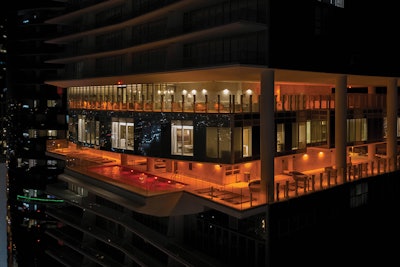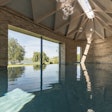
In August 2021, the American National Standards Institute (ANSI) approved the ANSI/PHTA/ ICC-10 2021 American National Standard for Elevated Pools, Spas and Other Aquatic Venues Integrated Into a Building or Structure. This is a major development, since this is the first recognized Standard or Code to specifically address elevated pools or spas. This new standard focuses on several areas, the most significant of which is the need for a secondary containment system in order to prevent water infiltration into the structure below.
Elevated pools and spas have been around for decades. Just as with any inground pool, a leak can occur in an elevated pool, due to the pump, a misplaced filter cap or a pipe break. When an inground pool has a minor leak, the water will end up in the ground, and does not typically cause significant damage to the property. When an elevated pool has a leak, unless a secondary containment system is present, the water can infiltrate whatever lies beneath, and cause substantial damage to the building’s electrical system, to units beneath the pool and their belongings, or even to the structural integrity of the building. When water (especially salt or chlorinated water) infiltrates concrete and reaches the rebar, it can cause unwanted corrosion.
This is why a secondary containment system is imperative to building safety. A secondary containment system is designed to catch any leaking water and direct it away from the places it shouldn’t go. It may work just like a catch pan under a washing machine or water heater, for example.
There are presently many ways to design a secondary containment system. For this reason, and to allow for new methods in the future, the PHTA-10 Standard does not prescribe any specific design or type of secondary containment system. One method presently available is the waterproof membrane used on a building rooftop to prevent rain or snow from entering.
Another important provision in PHTA-10 is the requirement that all potential leak points be accessible for inspection and repair. PHTA-10 states that any penetrations through the pool wall need to be accessible so that they can be inspected and repaired. If a pool or spa is leaking and you can’t access the leak point, then you can’t repair it, and that could lead to major problems.
While most jurisdictions that adopt PHTA-10 will likely target new construction, review and retrofitting of existing elevated pools should also be considered. And while the cost of installing a secondary system may be significant, the cost of doing nothing may be much greater.
You may be wondering who is responsible for understanding and following this new standard. The short answer is: everyone involved in the design, installation, and maintenance of an elevated pool or spa. This includes architects, engineers, facility managers, code inspectors, code officials, and anyone else who interacts with the elevated pool or spa. All should have a good understanding of the Standard, so the pool or spa is designed and installed correctly the first time, and properly maintained and inspected.
With PHTA-10 now available, state and local governments can begin to adopt codes that address it. A Standard is only effective where it is adopted, followed and enforced. Therefore, the development of PHTA10 cannot immediately eliminate all water infiltration episodes. It is, however, a giant step in this direction. As awareness about the importance of secondary containment spreads, we hope that new and existing facilities will take heed and that problems and disasters can be prevented in the future.
If you are interested in learning more about PHTA-10, Derek Downey, co-chair of the drafting committee and president of LegalPools.com, and I will be presenting at the 2022 World Aquatic Health Conference, taking place October 12-14 in Houston, Texas, on how this new standard applies to inspectors, facility managers, and others responsible for compliance and safety.
To learn more about, read or purchase a copy of the PHTA-10 standard, please visit the Pool & Hot Tub Alliance website, phta.org. This standard will be referenced in the 2024 International Swimming Pool and Spa Code (ISPSC), a document PHTA publishes in collaboration with the International Code Council.
Mark Trapani, PHTA-10 Standard Writing Committee Chair, is founder and managing member of UpStream Pools in Fairfield, NJ, providing consulting on installation planning, defect remediation and owner representation for elevated pools. Mark has installed, serviced, maintained and consulted on hundreds of elevated pools in New York City and nationally. An Air Force veteran, he has a bachelors and masters degree in engineering.
This article first appeared in the August 2022 issue of AQUA Magazine — the top resource for retailers, builders and service pros in the pool and spa industry. Subscriptions to the print magazine are free to all industry professionals. Click here to subscribe.











































